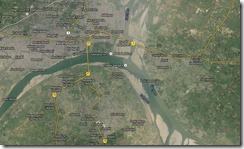 My posts this spring and summer have been so very infrequent! I’ve had a busy time with lots of visitors and my own travelling. Just last weekend my husband and I returned from a long road trip to the North of Spain, driving nearly 4300 kms in 16 days.
My posts this spring and summer have been so very infrequent! I’ve had a busy time with lots of visitors and my own travelling. Just last weekend my husband and I returned from a long road trip to the North of Spain, driving nearly 4300 kms in 16 days.
This was a trip that I had had in mind for quite some time. Five years back I had made plans to go on the famous Santiago de Compostela pilgrimage route with my two lady friends from Australia to celebrate all of us turning 50. We had planned to walk about 300 kms of this route but sadly for me, I had some health issues and could not join in. As it is unlikely that I would ever be able to do this walk, I took the opportunity this summer to do the route the easy way.
I have a great love of Cathedrals and in this trip we saw some really outstanding ones. I will never forget the sheer magnificence of the Burgos Cathedral, nor the magic of the stained glass at León. The Cathedral at Santiago de Compostela had that indescribable atmosphere that only holy places have. But this is a music blog; you’ll have to wait for my travel blog to read details about it all! Those of you who are wondering why this Iyengar woman goes on a Christian pilgrimage, I see the presence of God in the beauty of the architecture, in the skills of the artisans, in the creativity of the sculptors and painters, in the bhakti of all the believers who have come to these cathedrals for the last thousand years. And if I address Jesus or Mary with a couple of Hindu shlokas, I don’t think they mind very much!
This concept of a holiday which is a pilgrimage comes from my childhood. In fact, I used to think that was the way everyone had holidays! Come school break, my parents would take my sister and me to either our grandparents’ homes or on a teertha yatra, or a combination of the two. We went to many sthalas all over India but the most memorable ones for me involved a dip in Ganga. I remember the crowded ghats of Kasi, the swirling rush of Haridwar and Rishkesh, the freezing waters of Badrinath and the body-and-mind-numbing waters of Mandakini at Gaurikund, en route on our walk from Soneprayag to Kedarnath. (I just referred to my article published in my school magazine to remind me of the name of the place. If you would like to read of our pilgrimage at that time, here is a link to my rather immature article from 1975!) But most magical of all was a dip in Prayag at the Triveni Sangama; my then teenaged and very fanciful mind was quite taken by the idea of the hidden river Saraswati quietly flowing and meeting with Ganga and Yamuna.
And thus I come upon my song choice of today. Meera is said to have written Chalo Man Ganga Jamuna Teer in Prayag (unconfirmed). In her song, she says ‘O Mind, Go to Prayag’, The Prayag that she urges us to is not the confluence of the rivers but the sangama of the Nadis– Ida, Pingala and Sushumna– at the Ajna chakra (between our brows, position of the third-eye) . Ida is associated with Ganga, Pingala with Yamuna and Sushumna with Saraswati. This meeting point is called ‘Mukta Triveni’; it is the point of liberation. Meera urges us to this sangama, saying that the waters here are pure, stainless; such a dip, she says, will cool down our bodies. Cool from what? I imagine she means the heat of the passions and emotions that we live with. So, you see, though I have been on a many a pilgrimage, I have not dipped in the most important of sangamas. What use such physical pilgrimages then? !!
To listen to the song, there can be none other than the voice of D.V.Paluskar who made this song his own. Enjoy, and perhaps you will be inspired to take the dip that Meera urges us to. As the uploader has not allowed the video to be embedded, see it on YouTube on this link.
Footnote (Lyrics) :
Language : Rajasthani / Brijbhasa
(Lyrics as sung by D.V.Paluskar; I could not verify Meera’s original words which could well differ)
चलो मन गङ्गा-जमुना तीर ।
गङ्गा-जमुना निर्मल पानी ।
शीतल होत शरीर ।।
बंसी बजावत गावत कान्हा ।
संग लिये बलबीर ।।
मोर-मुकुट पीताम्बर सोहे ।
कुण्डल झलकत हीर ।।
मीरा के प्रभु गिरिधर नागर ।
चरण कमल पर सीर ।।
Transliteration
chalO mana gangA jamunA tIra
gangA jamunA niramala pAnI
shItala hOta sharIra
bansI bajAvata gAvata kAnhA
sanga liyE balabIra
mOra mukuTa pItAmbara sOhE
kuNDala jhalakata hIra
mIrA kahE prabhu giridhara nAgara
charaNa kamala para sIra
Translation
O Mind (mana), go (chalO) to the shores (teera) of Ganga and Yamuna (this means Prayag, where the two meet with Saraswati). The body (sharIra) becomes (hOta) cool (shItala) in the stainless (niramala) waters (pAnI) of Ganga and Yamuna.
There (implied), Krishna (kAnhA) is playing (bajAvata) his flute (bansI) and singing (gAvata), accompanied (sanga liyE) by Balarama (balabIra).
Krishna’s crown (mukuTa) of peacock (mOra) feathers and yellow garments (pItAmbara) suit him (sOhE). And from his earrings (kuNDala), diamonds (hIra) glitter (jhalakata).
Meera says (kahE) that her head (sIra) is on the lotus (kamala) like feet (charaNa) of her Lord who held up the mountain (giridhara nAgara).

